Endothelin-A-mediated vasoconstriction during exercise with advancing age
- PMID: 24821105
- PMCID: PMC4400393
- DOI: 10.1093/gerona/glu065
Endothelin-A-mediated vasoconstriction during exercise with advancing age
Abstract
The endothelin-1 vasoconstrictor pathway contributes to age-related elevations in resting peripheral vascular tone primarily through activation of the endothelin subtype A (ET(A)) receptor. However, the regulatory influence of ET(A)-mediated vasoconstriction during exercise in the elderly is unknown. Thus, in 17 healthy volunteers (n = 8 young, 24±2 years; n = 9 old, 70±2 years), we examined leg blood flow, mean arterial pressure, leg arterial-venous oxygen (O2) difference, and leg O2 consumption (VO2) at rest and during knee-extensor exercise before and after intra-arterial administration of the ET(A) antagonist BQ-123. During exercise, BQ-123 administration increased leg blood flow to a greater degree in the old (+29±5 mL/min/W) compared with the young (+16±3 mL/min/W). The increase in leg blood flow with BQ-123 was accompanied by an increase in leg VO2 in both groups, suggesting a reduced efficiency following ET(A) receptor blockade. Together, these findings have identified an age-related increase in ET(A)-mediated vasoconstrictor activity that persists during exercise, suggesting an important role of this pathway in the regulation of exercising skeletal muscle blood flow and maintenance of arterial blood pressure in the elderly.
Keywords: Aging.; Arterial; Blood; Endothelin-1; Exercise; blood p; flow; ressure.
© The Author 2014. Published by Oxford University Press on behalf of The Gerontological Society of America. All rights reserved. For permissions, please e-mail: journals.permissions@oup.com.
Figures

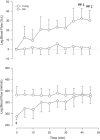
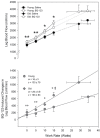
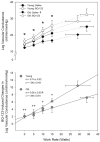
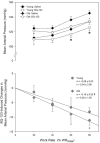
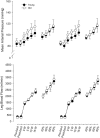
Similar articles
-
Taming the "sleeping giant": the role of endothelin-1 in the regulation of skeletal muscle blood flow and arterial blood pressure during exercise.Am J Physiol Heart Circ Physiol. 2013 Jan 1;304(1):H162-9. doi: 10.1152/ajpheart.00603.2012. Epub 2012 Oct 26. Am J Physiol Heart Circ Physiol. 2013. PMID: 23103494 Free PMC article.
-
Endothelin-1-mediated vasoconstriction at rest and during dynamic exercise in healthy humans.Am J Physiol Heart Circ Physiol. 2007 Oct;293(4):H2550-6. doi: 10.1152/ajpheart.00867.2007. Epub 2007 Aug 10. Am J Physiol Heart Circ Physiol. 2007. PMID: 17693542
-
Role of {alpha}1-adrenergic vasoconstriction in the regulation of skeletal muscle blood flow with advancing age.Am J Physiol Heart Circ Physiol. 2009 Feb;296(2):H497-504. doi: 10.1152/ajpheart.01016.2008. Epub 2008 Dec 5. Am J Physiol Heart Circ Physiol. 2009. PMID: 19060122 Free PMC article.
-
Endothelin-1 vasoconstrictor tone increases with age in healthy men but can be reduced by regular aerobic exercise.Hypertension. 2007 Aug;50(2):403-9. doi: 10.1161/HYPERTENSIONAHA.107.088294. Epub 2007 Jun 18. Hypertension. 2007. PMID: 17576858
-
Endothelin in the pulmonary circulation with special reference to hypoxic pulmonary vasoconstriction.Scand Cardiovasc J Suppl. 1997;46:1-40. Scand Cardiovasc J Suppl. 1997. PMID: 9265559 Review.
Cited by
-
Exercise intolerance in heart failure with preserved ejection fraction: Causes, consequences and the journey towards a cure.Exp Physiol. 2024 Apr;109(4):502-512. doi: 10.1113/EP090674. Epub 2023 Dec 8. Exp Physiol. 2024. PMID: 38063130 Free PMC article. Review.
-
Endothelin-1 inhibits size dependent lymphatic clearance of PEG-based conjugates after intra-articular injection into the rat knee.Acta Biomater. 2019 Jul 15;93:270-281. doi: 10.1016/j.actbio.2019.04.025. Epub 2019 Apr 12. Acta Biomater. 2019. PMID: 30986528 Free PMC article.
-
Matching of O2 Utilization and O2 Delivery in Contracting Skeletal Muscle in Health, Aging, and Heart Failure.Front Physiol. 2022 Jun 14;13:898395. doi: 10.3389/fphys.2022.898395. eCollection 2022. Front Physiol. 2022. PMID: 35774284 Free PMC article. Review.
-
'Fine-tuning' blood flow to the exercising muscle with advancing age: an update.Exp Physiol. 2015 Jun;100(6):589-602. doi: 10.1113/EP085076. Epub 2015 May 13. Exp Physiol. 2015. PMID: 25858164 Free PMC article.
-
Passive leg movement and nitric oxide-mediated vascular function: the impact of age.Am J Physiol Heart Circ Physiol. 2015 Mar 15;308(6):H672-9. doi: 10.1152/ajpheart.00806.2014. Epub 2015 Jan 9. Am J Physiol Heart Circ Physiol. 2015. PMID: 25576629 Free PMC article.
References
-
- Dinenno FA, Jones PP, Seals DR, Tanaka H. Limb blood flow and vascular conductance are reduced with age in healthy humans: relation to elevations in sympathetic nerve activity and declines in oxygen demand. Circulation. 1999;100:164–170. - PubMed
-
- Lawrenson L, Poole JG, Kim J, Brown C, Patel P, Richardson RS. Vascular and metabolic response to isolated small muscle mass exercise: effect of age. Am J Physiol Heart Circ Physiol. 2003;285:H1023–H1031. 10.1152/ajpheart.00135.2003 - PubMed
-
- Lawrenson L, Hoff J, Richardson RS. Aging attenuates vascular and metabolic plasticity but does not limit improvement in muscle VO(2) max. Am J Physiol Heart Circ Physiol. 2004;286:H1565–H1572. - PubMed
Publication types
MeSH terms
Substances
Grants and funding
LinkOut - more resources
Full Text Sources
Other Literature Sources
Medical

